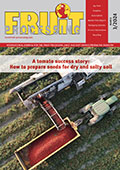According to a recent study conducted by Fact.MR, the global citrus fiber market reached a valuation of USD 317 million in 2022 and is projected to achieve USD 550 million by the conclusion of 2032. The market is anticipated to witness an expansion of demand opportunities at a Compound Annual Growth Rate (CAGR) of 5.6 % through the forecast period. A primary driver stimulating growth within the global citrus fibers market is the escalating demand for natural, plant-based ingredients in both food and personal care products.
The surge in demand for gluten-free and vegan products within the food and beverage sector is a significant contributor to the heightened sales of citrus fibers. As consumers increasingly become aware of the adverse health effects associated with the consumption of processed foods, there is a notable shift towards plant-derived ingredients, thereby fostering growth prospects within the citrus fibers market.
Citrus fibers are emerging as effective alternatives to sodium triphosphate, thereby augmenting their incorporation in processed meat products. This trend is further bolstering the market for citrus fibers, as manufacturers seek cleaner and more natural ingredients to meet consumer preferences and industry standards.
Furthermore, citrus fibers exhibit a high fat-binding capacity and are adept at stabilising emulsions, making them increasingly sought-after in the bakery and confectionery sectors. This growing utilisation of citrus fibers in such applications is expected to contribute favorably to the market’s growth trajectory in the foreseeable future.
Expanding beyond the realm of food and beverage, citrus fibers are gaining prominence in skincare and personal care products as well. With their rich vitamin C content, citrus fibers offer benefits such as improving skin tone, reducing dark spots, and addressing hyperpigmentation. These attributes have led to heightened interest in orange and lemon citrus fibers for incorporation into skincare products, consequently driving up their sales.
Leading players in the citrus fiber market include:
- CEAMSA
- Fiberstar, Inc.
- CP Kelco, Inc.
- Herbafoods Ingredients GmbH
- Florida Food Products, Inc.
- Golden Health
According to Fact.MR’s analysis, the demand for citrus fibers is poised to witness a notable uptick in the United States, fueled by the increasing adoption within the food and beverage as well as personal care industries. Moreover, the rising preference for vegan and plant-based products across the nation is expected to sustain and further boost the sales of citrus fibers in the years leading up to 2031.
Key takeaways from citrus fiber market analysis:
- Based on applications, personal care segment is projected to grow at a 5 % CAGR, remaining a dominant area of application.
- By function, citrus fibers as water binders & fat replacers will account for over 50 % of the total market share through 2031.
- The U.S. is estimated to account for 9/10th of the total citrus fibers market sales, placing the country as a lucrative market.
- Increasing popularity of gluten-free and plant-based ingredients in Brazil will augment market growth, holding over 40 % of the total market share by 2031.
“Surging cases of food-borne diseases due to artificial flavours and colours used in processed food will encourage adoption of natural citrus fibers. Considering this, sales of citrus fiber-based pharmaceuticals will increase, further augmenting growth in the market through 2031,” says the Fact.MRanalyst.
Growth drivers:
- Growing awareness regarding negative health effects of synthetic flavouring in food products will favour adoption of citrus fibers.
- Increasing significance of clean labels in food and personal care products will drive sales of citrus fibers.
Market segmentations:
- by nature: organic, conventional
- by grade: food-grade, pharma-grade, others
- by source: oranges, tangerines/mandarians, grapefruit, lemons and limes
- by function: gelling gums, thickening gums, water binders & fat replacers
- by application: desserts and ice-creams, snacks and meals, bakery products, sauces and seasonings, meat & egg replacements, personal care, pharmaceuticals, beverages, flavourings, and coatings, others
- by distribution channel: online channel, convenience stores, supermarkets and hypermarkets, department stores, specialty stores, pharmacies
- by region: North America, Europe, Asia Pacific, Latin America, Middle East & Africa
Competitive landscape
Major citrus fiber suppliers are actively broadening their consumer reach to establish a dominant market presence in the foreseeable future. Employing arange of strategic approaches, these suppliers are pursuing growth opportunities within the market. These strategies encompass various tactics such as mergers, acquisitions, collaborations, expanding company footprints, forging partnerships, launching innovative products, and more.
Recent developments
- Azelis, in July 2021, established a collaboration with CP Kelco to broaden its capabilities for distribution around the Netherlands for citrus fibers and some other natural food ingredients.
- Fiberstar Inc., in 2019, launched a new website for citrus fiber Citi-Fi to showcase its products along with providing education to consumers around the world. The company is also taking initiatives to improve its digital experience.
- Orange Fiber is a popular startup that has announced the launching of a novel fabric range made from pulp and citrus fiber with collaborations with Marinella brands and H&M.
- CP Kelco is a leader that provides solutions in natural ingredients and has unveiled the launch of a novel innovation center for pilot plant scale-up and research applications.
These insights are based on a report on Citrus Fiber Market by Fact.MR.
According to data released by Fact.MR, a provider of market research and competitive intelligence, the global alcopop market is anticipated to reach a value of USD 8.1 billion by the end of 2033, increasing at a CAGR of 6 % from 2023 to 2033.
Alcopops are Ready to Drink (RTD) beverages that are available in pre-mixed forms containing different flavoured spirits and can be consumed directly. Lesser content of alcohol in alcopops as compared to conventional alcoholic beverages is a key factor driving their consumption.
Increasing per capita disposable income of people around the world is predicted to have a direct impact on the expenditure capacity of individuals. They are spending at a noticeable rate in different lifestyle products, including beverages and food at restaurants & cafés. Increasing inclination for alcoholic and non-alcoholic beverages that impart refreshing and unique flavours are expected to bolster the demand for alcopops around the world.
High concentration on R&D activities has resulted in fortifications and innovations in numerous spirit varieties, which is predicted to support in generating lucrative opportunities for market players. Rising population of young people and their inclination towards a wide variety of premium beverages is projected to stimulate the demand for alcopops over the coming years.
Key takeaways from market study
- Worldwide demand for alcopops is estimated at USD 4.5 billion in 2023.
- The global alcopop market is predicted to advance at a CAGR of 6 % from 2023 to 2033.
- The global industry is expected to reach USD 8.1 billion by the end of 2033.
- Europe held more than 35 % share of global market revenue in 2022.
- Sales of vodka-based alcopops are anticipated to rise at a CAGR of 4.7 % from 2023 to 2033.
“Rising popularity of alcopops is attributed to the global availability and traction for different flavours. Moreover, increasing popularity of some unique flavours in alcoholic beverages is contributing to the rising share of alcopops in the liquor industry,” says a Fact.MR analyst.
Rising popularity of alcopops among teenagers
In recent years, there is a noteworthy increase in the population of young people. They are inclined to consume premium alcoholic beverages, which are estimated to open up new opportunities for players. Alcopops are sweetened drinks, which are receiving enormous popularity, especially among teenagers worldwide. Youngsters are consuming alcopops due to two main reasons:
- Alcopops do not taste like alcohol but rather have a sugary-sweet and fruity taste. Alcopops are made more palatable to new drinkers due to their ability to conceal the bitter taste of alcohol.
- Alcopops are available in attractive packaging with colourful and bright labels, which make them appear more attractive to young consumers.
Awareness about danger caused due to excessive consumption of alcopops and implementation of stringent regulations
Alcopops are not entirely safer compared to other alcoholic beverages. Excessive consumption of alcopops can have fatal results. Even, habitual drinking of alcopops can result in life-changing consequences.
Over the years, excessive consumption of alcopops has increased concerns among healthcare professionals, parents, and government agencies. The attractive advertisement manners in which it seems to be promoted as an underage drink is one of the key factors to stimulate sales of alcopops. Therefore, an increase in the consumption of alcopops is expected which can adversely impact individuals’ health.
Respective governing bodies around the world have imposed certain regulations against the consumption of alcoholic beverages. These regulations are predicted to restrict growth opportunities in the target industry.
Key industry players
Key suppliers of alcopops operating around the world include Asahi Group Holdings, Ltd., Halewood International Limited, Suntory Holdings Limited, Mike’s Hard Lemonade Co., United Brands Company, Inc., Bass Brewery, Pabst Brewing Company, and Molson Coors Brewing Company.
The increasing trend of consuming organic food products along with healthy eating habits, especially among the young generation, is driving the demand for smoothies. According to the latest data provided by Fact.MR, a market research and competitive intelligence provider, the global smoothies market is estimated to reach a value of USD 52.5 billion by the end of 2033, expanding at a CAGR of 6.8 % during the forecast period (2023 to 2033).
Smoothies refer to thick beverages that are made by blending assorted vegetables, fruits, and other ingredients such as sweeteners, ice cubes, yogurt, seeds, milk, and herbal and nutritional supplements. They are rich in nutrients, including fibers and vitamins, and are easy to prepare and store for consumption. More people nowadays are also including green leafy vegetables such as lettuce, collard greens, spinach, and kale due to the increasing trend of green smoothies. These green smoothies are consumed to improve digestion, boost immunity, and minimise unhealthy food cravings.
Nutritional deficiencies and malnourishment have been affecting a large part of the population across several countries. However, over the years, due to improving economic conditions, these issues have been largely replaced with chronic diseases such as epilepsy and heart attacks, diabetes, obesity, strokes, and arthritis, especially in developed nations.
- According to CDC (Centers for Disease Control and Prevention), chronic diseases are one of the prominent health problems in the United States.
More people are becoming health conscious and are adopting healthier lifestyles by making alterations to their everyday diets. There has been a remarkable shift from carbohydrate-laden food products to healthy protein-enriched meals and snacks, in terms of demand. Furthermore, functional foods and beverages such as smoothies are also consumed by many people to meet their routine nutritional requirements.
Long working hours and hectic lifestyles are stimulating the demand for on-the-go-meal options, which, in turn, is strengthening the growth opportunities for market players. Key manufacturers are focusing on new product launches and strategic initiatives to drive market growth over the coming years.
Vegetables and fruits are used as major raw ingredients in the production of smoothies. Fluctuations in the prices of raw materials due to climatic changes can directly impact the cost of the final product. This is expected to restrain market growth to some extent.
Key Takeaways from Market Study
- The global smoothies market is anticipated to reach a value of USD 52.5 billion by the end of 2033.
- Demand for smoothies is forecasted to increase at a CAGR of 6.8 % during the forecast period from 2023 to 2033.
- The global market for smoothies is valued at USD 27.2 billion in 2023.
- The fruit-based segment is expected to account for more than 50 % market share by the end of 2033.
- Sales of smoothies in Germany are projected to increase at a CAGR of 4.8 % from 2023 to 2033.
- Demand for smoothies in Canada is set to expand at a CAGR of 5.5 % through 2033.









